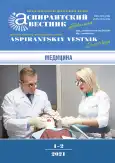Анализ напряженно-деформированного состояния цифровой модели реконструктивного лиофилизированного аллогенного костного имплантата при изменении его конструктивных особенностей
- Авторы: Ипполитов А.А.1, Попов Н.В.1
-
Учреждения:
- Федеральное государственное бюджетное образовательное учреждение высшего образования «Самарский государственный медицинский университет» Министерства здравоохранения Российской Федерации
- Выпуск: Том 21, № 1-2 (2021)
- Страницы: 15-20
- Раздел: 14.01.00 Клиническая медицина
- URL: https://journals.rcsi.science/2410-3764/article/view/108821
- DOI: https://doi.org/10.55531/2072-2354.2021.21.1.15-20
- ID: 108821
Цитировать
Полный текст
Аннотация
- Обоснование. Благоприятный исход восстановления убыли костной ткани челюстей зависит от множества факторов. Так, одними из ключевых факторов являются данные о механических и биофизических особенностях применяемых костных имплантатов, незнание которых нередко ставит под угрозу успешное проведение лечения стоматологических пациентов.
Цель — провести сравнительный экспериментальный анализ напряженно-деформированного состояния цифровой модели реконструктивного лиофилизированного аллогенного костного имплантата при изменении его конструктивных особенностей.
Материалы и методы. Для определения биомеханических показателей сохранения целостности был проведен анализ напряженно-деформированного состояния математических моделей реконструктивного цилиндрического имплантата и реконструктивного имплантата из лиофилизированного аллогенного материала в равных условиях с использованием метода конечных элементов.
Результаты. В результате проведенного анализа напряженно-деформированного состояния цифровых 3D-моделей реконструктивных костных имплантатов двух видов получены распределения напряжений по Мизесу (эквивалентные напряжения), вызванные действием заданных нагрузок. При исследовании были получены данные о запасе прочности реконструктивных имплантатов.
Заключение. Возможности современного компьютерного программного обеспечения позволяют расширить возможности проведения костной аугментации альвеолярной костной ткани челюстей с одномоментной дентальной имплантацией, позволяя аналитическим путем найти оптимальные параметры применяемых материалов, выбрать величину и направление силы при их установке, а также спрогнозировать их поведение в постоперационном периоде.
Полный текст
Открыть статью на сайте журналаОб авторах
Алексей Андреевич Ипполитов
Федеральное государственное бюджетное образовательное учреждение высшего образования «Самарский государственный медицинский университет» Министерства здравоохранения Российской Федерации
Автор, ответственный за переписку.
Email: ippolitoff.al@yandex.ru
ординатор кафедры стоматологии ИПО
Россия, СамараНиколай Владимирович Попов
Федеральное государственное бюджетное образовательное учреждение высшего образования «Самарский государственный медицинский университет» Министерства здравоохранения Российской Федерации
Email: 2750668@mail.ru
заместитель директора института стоматологии, доктор медицинских наук, профессор кафедры стоматологии детского возраста и ортодонтии
Россия, СамараСписок литературы
- Гветадзе Р.Ш., Федоровский А.Н., Козлова Л.С. Широков Ю.Ю . Консольный элемент в несъемной ортопедической конструкции с опорой на дентальные имплантаты: влияние на напряженно-деформированное состояние кости // Стоматология. 2016. T. 95, № 4. С. 62–64. doi: 10.17116/stomat201695462-64
- Мураев А.А., Гажва Ю.В., Ивашкевич С.Г. и др. Новый подход к объемной реконструкции сложных дефектов альвеолярной кости // Современные технологии в медицине. 2017. Т. 9, № 2. С. 37–45. doi: 10.17691/stm2017.9.2.04
- Цициашвили А.М., Силантьев А.С., Панин А.М. и др. Биомеханика короткого дентального имплантата в костной ткани нижней челюсти // Стоматология. 2019. Т. 98. № 6–2. С. 33–36. doi: 10.17116/stomat20199806233
- Hanser T., Khoury F. Alveolar ridge contouring with free connective tissue graft at implant placement: A 5-year consecutive clinical study // Int J Periodontics Restorative Dent. 2016. Vol. 36, No. 4. Р. 465–473. doi: 10.11607/prd.2730
- Yamada M., Egusa H. Current bone substitutes for implant dentistry // J. Prosthodont. Res. 2018. Vol. 62, No. 2. Р.152–161. doi: 10.1016/j.jpor.2017.08.010
- Premnath K., Sridevi J., Kalavathy N., et al. Evaluation of stress distribution in bone of different densities using different implant designs: a three-dimensional finite element analysis // J Indian Prosthodont Soc. 2013. Vol. 13, No. 4. Р. 555–559. doi: 10.1007/s13191-012-0189-7
- Urban I.A., Montero E., Monje A., Sanz-Sánchez I. Effectiveness of vertical ridge augmentation interventions: A systematic review and meta-analysis // J Clin Periodontol. 2019. Vol. 46 Suppl 21. Р. 319–339. doi: 10.1111/jcpe.13061
Дополнительные файлы











